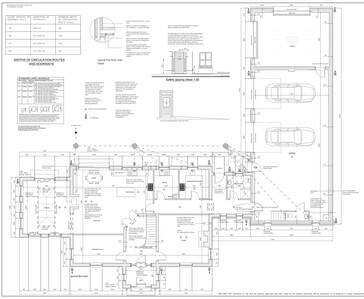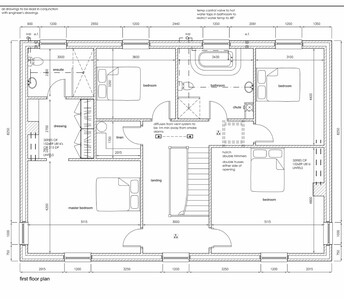Advice for ground source heat pump in new build with PV and batteries
Hi everyone.
We are currently building a house and garage with a total of 406 square metres that will have under floor heating.
Our heating engineer initially quoted us for an ASHP but came to the conclusion that even the largest single phase one they could supply would be working too hard due to the size of the property that it would be heating.
We own the surrounding field and lease it for farming so using an area of it for geothermal pipe work isn’t an issue.
We have been given 2 options for a GSHP.
The cheaper option is a Warmflow GS03 4.5kw - 18kw.
The more expensive option is an Ecoforest B1 3 -12kw.
I know the Ecoforest unit has more features.
What should I go for?
What soil considerations should we have?
We have a pretty extensive 18.9kw solar setup in place with an estimated annual output of 14978kwh (please note we have an EV too).
It will feature a Gateway, 10kw inverter (pending G99 approval), 42 All black panels with in-roof system, an eddi for water heater and 4 x 8kw batteries (upgradable to 6).
Any advice / recommendations welcome. Thanks in advance.
First question is why do you think you need 18kW? Whats the house construction and where are you? 45W/sq m is high for a modern purpose built house, what does the SAP figure say? Even my 1930s house, albeit with partial fabric upgrades, is only 35W/sq m. Is yours well insulated or poorly and what's the form factor (eg cubic or single storey long and thin) Some so called M&E consultants appear to have little or no understanding resulting in gross over specification.
It feels to me like you may be creating problems by overestimating the requirement. If that's the case you will not only cost yourself trouble and money now, you will have continual problems in the future. Best to get a firm grip now while there is time to get it right.
4kW peak of solar PV since 2011; EV and a 1930s house which has been partially renovated to improve its efficiency. 7kW Vaillant heat pump.
Welcome to the forums. Given the scale of your property, and the fact you have access to land (and budget), ground source definitely makes sense as a long-term solution.
You might also want to explore PV-T as a complementary option alongside your solar PV array. NIBE offer a solid solution in this space, and if you’re still open to alternatives, both NIBE and Kensa produce well-established and reliable GSHP units that are worth considering.
On the groundworks side, if you’re planning horizontal loops, soil thermal conductivity (I've been told) is a critical factor. Clay soils are excellent for heat transfer, while sandy or rocky soils tend to perform poorly and may require longer trenches. If you’re unsure, a thermal response test or at least a soil assessment could prevent performance or sizing issues down the line.
Let us know how things progress... it sounds like an exciting setup.
Rick Clark from NIBE discusses PV-T in this episode (just skip to the PVT timestamp):
Get a copy of The Ultimate Guide to Heat Pumps
Subscribe and follow our YouTube channel!
Many thanks.
We are at first fix stage and the panels are in place (PV in roof system).
I am almost dead set on a GSHP but I’m just wondering if it would be wise to lay pipes to leave the option for an oil fired heating system should the GSHP not work out? We have no mains gas in our area.
A lot of people (including my father in law who is a retired plumber) are dubious about any form of heat pump and think I should be going oil fired especially given how cheap oil is at the moment. That’s liable to change at the drop of a hat though as we all know.
The house is based in Northern Ireland and is block with foil backed insulation, bison slabbed upper floors (inc garage) and double glazed windows. It is a traditional country / Georgian style house with 2 open flues (see 3D image below).
It will have under floor heating throughout (including the upper floor of the garage which is 110m2).
SAP rating came back at 89B if that makes sense?
We will also have a MVHR system installed.
I'm not an expert on SAP TBH but others here are. Could you post the full report (feel free to redact personal info) which will give a better insight and I believe has a loss spec? With your description of the build I'm even more struggling to believe 18kW
Heat pumps properly installed work well. Mine is working out 20% cheaper than gas, is far more comfortable than the boiler it replaced, and is about the simplest possible design you can imagine (heat pump, diverter valve to switch between dhw and space heating, no external controls, no buffer tanks, no zoning, no etc). I'm running at a flow temp of 42, yours should be 35 or less and thus at least 20% cheaper still.
I'm seriously concerned you are being talked into well over specifying and risk degrading performance. What's the system layout/design?
What are the open flues for functionally.
If you are set on a heat pump for goodness sake get one, just make sure the system is well designed which this forum can help with.
4kW peak of solar PV since 2011; EV and a 1930s house which has been partially renovated to improve its efficiency. 7kW Vaillant heat pump.
We are at 192m² living space, and our house requires 3.5kW at -9. If we built to minimum building regs that number jumps to about 5kW. So a little confused why. So would doubt you need anywhere the size you quote.
Have you done a heat loss calculation? I do mean you.
Not sure the great expense of a gshp is worth it. An ASHP is easy to install gives a pretty good running cost when coupled to UFH or low temp radiators.
With MVHR what level of airtightness are you aiming for?
I’ll not post the entire SAP report as the whole thing (along with thermal bridging and U value reports) is about 30 pages long.
I can try and find any bits of info that anyone thinks would be beneficial though?
One flue is for a multi fuel stove and the other is for an open fire.
Posted by: @gcon45other is for an open fire
So why waste your money on MVHR? You aren't airtight so why not MEV or dMEV? You need ventilation bricks etc in walls MVHR is a bit of a nonsense and really odd with open fires. MVHR works with airtight houses, in anything else it's additional heat losses.
You are actually increasing the heat demand not reducing it. The real issue is when your open fire is running, reducing internal pressure and letting the fire spill in to the house, instead of up the chimney. Not healthy.
Yeah the flue for the fire will be sealed up for about 360 days of the year with a draught excluder.
It’s a traditional house so it’s in keeping with the style.
I’d imagine the fire will only ever be actually lit around Christmas time.
Posted by: @gcon45I’d imagine the fire will only ever be actually lit around Christmas time.
You still.need all the air inlets - So air bricks that cannot be closed, to comply with the rules, open 365 days for 5 days of open fire? Sorry that's nuts. Why not a room sealed stove, good airtightness, no air bricks etc etc...
- 26 Forums
- 2,356 Topics
- 53.4 K Posts
- 234 Online
- 6,017 Members
Join Us!
Worth Watching
Latest Posts
-
RE: Octopus Cosy Heat Pump Owners & Discussion Thread
@kevh with the Cosy 6 I know it definitely goes to arou...
By HarrisonC , 11 hours ago
-
RE: Setback savings - fact or fiction?
@cathoderay yes I am familiar with SQL. Interesting num...
By RobS , 12 hours ago
-

Parsnip, Bacon & Coconut Milk Soup
First let me say, I am only a cook because I am human a...
By Toodles , 12 hours ago
-

RE: Controlling Daikin Altherma via P1P2 and Home Assistant
@weoleyric Oh Dear, I don’t think I am going to be of m...
By Toodles , 13 hours ago
-
RE: Electricity price predictions
Ben Watts posted on LinkedIn that he had updated this w...
By Judith , 18 hours ago
-

RE: The good, the bad and the not that great – my heat pump installation
Small update, Emailed and Spoke to Midea UK and they ...
By Burtis , 18 hours ago
-
RE: Solis S6-EH1P8K-L-PLUS – Why I Chose It and What I’ve Learned So Far
@bash Octopus does charge for the admin. The process al...
By Batpred , 18 hours ago
-
RE: External pipework insulation
@transparent HI all The products you mention are ver...
By David Smith , 18 hours ago
-
RE: New Fogstar 15.5kWh upright solution
Issues still under investigation by Solis... Fogstar ...
By Batpred , 18 hours ago
-
RE: Who's your electricity provider and what's your tariff?
I agree, the consumer is not being properly represented...
By Batpred , 19 hours ago
-
RE: Advice on internal circulation pump noise
Thanks @mikefl - I'll maybe have a look at the lock-shi...
By jtg , 1 day ago
-

RE: Heat Pump Heats the House… But It’s Not Cosy. Emitter Changes or System Tweak?
@toodles interesting suggestion, thanks. I will try to...
By GrahamF , 1 day ago
-
RE: Mitsubishi Ecodan Auto Adaption trial to stop cycling.
The interval you talk of, i think, will be 60min for an...
By F1p , 2 days ago
-
Agree with @majordennisbloodnok on the setbacks. We hav...
By ChandyKris , 2 days ago
-

RE: Speedcomfort radiator fans
@deltona the way the links were added broke the page. A...
By Mars , 2 days ago
-

RE: Refrigerant R32, is it now banned in the EU from 1st Jan 2027 for monobloc ASHPs?
This has been delayed from what I believe to be this ye...
By dgclimatecontrol , 3 days ago
-
RE: Are We Sleepwalking Into Another Race to the Bottom?
this is why I provided current flow temperatures in the...
By ksim , 3 days ago
-

RE: Why Millions of UK Homes Struggle With Heat Pumps
There's many homes that would be quite a disruption for...
By dgclimatecontrol , 3 days ago
-
RE: Ecodan unable to hit legionella target temp - what's the consensus?
@rhh2348 ...maybe this option is what you want? Alter...
By benson , 3 days ago









